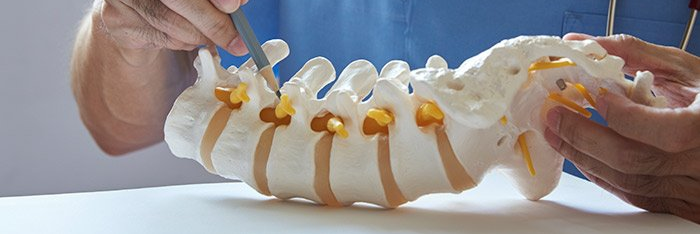Degenerative lumbar disc disease
¿Qué es una discopatía lumbar degenerativa?
The spine is made up of vertebrae stacked on top of each other, and the last five vertebrae form the lumbar spine, which sits above the sacrum. Between each vertebra is a disc that serves as cushioning. The disc is made up of two parts: a central one called the nucleus pulposus and a peripheral one called the annulus fibrosus. If the annulus fibrosus is injured, the nucleus pulposus can bulge out of the annulus and compress the nerves inside the spine. This condition is called a herniated or slipped disc, which can occur in the lumbar or cervical spine. When the disc is worn without rupturing and does not cause a herniation or compress the nerves, it is called disc disease. Significant disc disease can lead to the development of local osteoarthritis or spinal biomechanical problems that cause chronic pain.
How does lumbar disc disease occur?
Lumbar disc disease can be normal or premature and is associated with specific problems such as excess weight, carrying heavy objects, working with frequent vibrations or impacts, and prolonged posture. In disc disease, the intervertebral disc dehydrates, primarily affecting cushioning. This can create local microtraumas that cause pain and muscle spasms, resulting in lumbago (lower back pain).
Symptoms of lumbar disc disease
Symptoms of degenerative lumbar disc disease are usually located in the lower back and may include:
- Low back pain
- Lumbosciatic pain (Pain that radiates to the legs)
- Muscle weakness in the legs and feet
- Tingling or numbness in the legs
- Difficulty walking
- Persistent pain
- Lower back pain when bending over.
How do I know if I have lumbar disc disease?
If you experience any of the symptoms mentioned above, a spine specialist will evaluate you. This will include a physical exam and imaging tests such as a CT scan or MRI.
Treatment for disc disease without surgery
Nonsurgical treatment for degenerative lumbar disc disease includes physical therapy, pain medication, stretching and strengthening exercises, occupational therapy, and acupuncture. In some cases, traction devices or the application of heat or cold to the affected area may be used.
Surgery for degenerative lumbar disc disease
The goal of surgery is to relieve pain and improve the patient's quality of life. The decision on treatment is never urgent and should be carefully discussed between the patient and their surgeon. There are several surgical techniques for treating disc disease, such as posterior lumbar arthrodesis, anterior lumbar arthrodesis, and lateral disc replacement. The surgeon will choose the appropriate technique for each patient based on their individual case. In some cases, lumbar disc replacement is used, and this technique will be determined based on the patient's needs and characteristics.
If nerve decompression is necessary due to a herniated disc or osteoarthritis in addition to disc disease, the surgeon will opt for posterior approach surgery (through the back). Posterior approach lumbar arthrodesis involves blocking the painful level(s) to limit movement of the affected disc. This type of surgery allows the affected disc to be removed and replaced with cages containing natural bone or bone substitute. This construct heals within a few months, reducing pain. The surgeon will complete the procedure by placing two screws in each vertebra to stabilize the construct, or a spacer or ligament to achieve the same function.
If nerve decompression isn't necessary, the surgeon may discuss anterior or lateral surgery (an approach through the abdomen or side). This type of surgery avoids damaging the back muscles and, therefore, allows for faster recovery and rehabilitation.
Anterior lumbar arthrodesis involves blocking the painful level(s) in the same way as posterior arthrodesis, but in this case, the disc will be replaced with a larger cage held in place by screws in the vertebrae.
Anterior disc replacement allows the disc to be replaced in the same way, but maintains mobility at the affected level and is indicated for patients where all other elements are in perfect condition.
Lateral disc replacement involves minimally invasively replacing the damaged disc with a new one. It is performed on the side of the body.
It is important to keep in mind that surgery for degenerative lumbar disc disease should never be an emergency, but rather a carefully considered decision between the patient and their surgeon.
We can help you with your spine problem
Solicita hoy tu consulta online gratuita para valorar tu caso.
💡 Remember: For more advanced treatments, you may need to visit one of our clinics in Spain.




